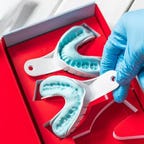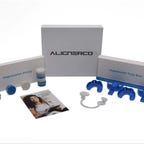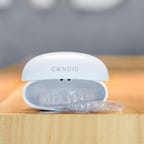Best Invisible Braces for 2024
Clear aligners are a great alternative for many people, but companies vary drastically in price, medical oversight and treatment plans.
What to consider
Direct-to-consumer vs. provider-assisted aligners
Health of your mouth
Reason for wanting invisible braces or clear aligners
Consistency
Our Picks
Straightening your teeth has always been associated with metal braces, but advancements in dental technology and health care have given people a new option: "invisible braces" or clear aligners. Today, people have more choices than ever in deciding what company to choose and which direction to take their teeth-alignment journey.
Clear aligners or invisible braces have a few big caveats: there's a difference between companies like Invisalign -- which requires some in-office appointments with a dental professional -- and direct-to-consumer sites that take molds remotely and ship aligners to your house without any check-ups. Mostly, direct-to-consumer sites are more affordable, but they are generally not recommended by many dental and orthodontic professionals, including the American Dental Association.
After SmileDirectClub shut down in December, leaving many customers in the middle of their treatment, the ADA issued a general statement (which did not name any particular company) about the potential dangers of straightening your teeth at home without medical oversight. In some cases, moving teeth without knowing the full picture of someone's oral health can cause bone loss, teeth loss, gum issues, bite problems, pain in the jaw and permanent issues, the ADA said.
This isn't to scare you out of a treatment you want, but it's an important reminder that our teeth are an important part of our body -- the head -- and safely straightening your teeth needs to be considered in the context of your gum health, bone health, the roots of your teeth, your jaw and more, according to Dr. Kami Hoss, orthodontist and founder of SuperMouth, an oral care company. You can't understand that context without an examination by a doctor and some X-rays, Hoss said.
He doesn't recommend direct-to-consumer aligners for the majority of people (more on that below), but people who are interested in straightening their teeth solely at home should be sure to get an exam of their oral health before they go ahead, Hoss said. He added that many orthodontists already offer free consultations, so there's a chance you'll be able to finesse a no-cost dental exam before you make your decision. (Here's a provider-finder link from the American Association of Orthodontists, or you can call your local dentist.)
“If you are gonna be in that group where you absolutely want to do this at home, at least get the orthodontic consultation," Hoss said. "Get a feel for how complex your case is.”
'Appointment-required' aligners vs. 'at-home only' aligners
If you're going the in-office aligners route, an exam of your mouth and dental X-rays should be included in the company's care plan and whichever doctor's office you're working with. Dentists and orthodontists can become providers with different aligner companies, including the likes of Invisalign, Spark, Reveal and Candid. You'll have appointments along the way to check your progress, but the frequency of your appointments and what your care plan will look like depends.
In addition to having oversight by a doctor who can adjust treatment if something isn't working, Hoss said another plus of these clear aligner companies is that they offer attachments in many cases. Attachments are small, often unnoticeable little nubs attached to some teeth that hook to the aligner and help them move. He compared attachments to handles on furniture.
"If you want to open a cabinet or move it around, it’s a lot easier to have a handle on that cabinet," he explained.
If you prefer your treatment strictly from home (direct-to-consumer), you'll normally sign up through the company's website and wait for your shipment of an at-home mold to provide an impression of your teeth. Then, the company's medical network will review the results of your mold to determine whether you can go forward with treatment. You'll be shipped new aligners every couple of weeks or so, depending on the company and your individual plan. Because at-home only companies are just that -- at home -- you won't get attachments.
According to Hoss, people who could benefit from a direct-to-consumer alignment option include what he calls "minor relapse cases." These are people who may've already had braces, but their bottom teeth have moved a little and they need some minor aligner treatment to straighten them back up again.
Again, he stressed the importance of having confirmation that your teeth and everything else are healthy. In some cases, evidence of damage caused by unsafe teeth alignment may show up years later when someone goes to the dentist for another problem, according to Hoss. Also, he said, straightening your teeth with aligners -- even if effective at first -- may miss the root of the issue, and ignoring the cause of the problem may cause problems or cause teeth to revert back after initial treatment.
Wherever you get your clear aligners, they'll typically need to be worn throughout the day, unless you're eating. Some people may also choose a "night-time only" plan.
While what's best for you will depend on your needs, here are some companies to consider.
Best invisible braces
Invisalign is the name that kicked the whole idea of invisible braces into the mainstream. It works similarly to "traditional" braces in that you'll need to find a doctor to start your treatment and work alongside for your entire treatment plan. You'll find a provider in your area, come up with your treatment plan, get fitted for attachments or whatever you need and then be on your way to straighter teeth.
The cost is comparable to regular braces, Invisalign says, although how much you'll end up paying will depend on your specific needs. Depending on your plan, dental insurance may cover up to $3,000 of the cost, according to Invisalign, and you can use your FSA/HSA dollars. Because you'll be working with a doctor, you may also be able to work out some sort of payment or installment plan.
After treatment, your doctor may recommend you use a retainer to keep your teeth in place. How that looks will depend on your treatment plan.
Best stain-resistant aligners
Reveal
Reveal is similar to companies like Invisalign and Spark because it requires check-ups and appointments with a dentist or orthodontist to keep you on track throughout your treatment.
We're including it on this list because the claims the company makes on its website may make it a good aesthetic option for people more concerned about the clarity of their aligners. Reveal says that its aligners are guaranteed to maintain their clarity after two weeks of wear and drinking things like coffee. The company also says it'll minimize its use of attachments, which are typically used for clear aligners since they help teeth move but some people may want to minimize them.
To get started, find a provider in your area by searching your ZIP code. Reveal says its prices are between $2,000 and $5,000, and the company has a monthly payment option.
Best direct-to-consumer option
Byte
Byte doesn't require appointments or fittings from a dental health provider, but it's relatively well-known in the field of direct-to-consumer dentistry. It's one of the few companies still in business that hasn't moved to require some doctor appointments (like Candid, which once was direct-to-consumer but has moved to a more hybrid model with a provider-assisted approach), but it may be inching that way. Byte has a premium option for its aligners which includes a free 1:1 consultation with an affiliated dentist to see if you're right for the aligners, as opposed to just sending in at-home molds and getting virtual medical clearance.
Byte says its average treatment time is four months. The impression kit costs $95 and is sold separately; the all-day clear aligners cost $2,099 for a one-time payment or $89 per month for 36 months.
A cool addition from Byte is that it offers a tool called the HyperByte, which is a vibration therapy that sends pulses through your teeth to help seat your aligners for better treatment. Byte also includes your first set of retainers for free after treatment.
Byte says you'll get a refund for the impression kit you order if you are not a good candidate for treatment. As part of the company's guarantee, Byte says you may be eligible for additional aligners and a new treatment plan at no additional cost if your teeth move out of place and you follow your treatment plan's rules. It doesn't say anything about refunding the price of your treatment if you're unhappy with it for any reason.
Best budget friendly direct-to-consumer option
AlignerCo
AlignerCo is a direct-to-consumer company, so it's best to get a clean bill of oral health from your dentist -- and ideally a consultation with an orthodontist -- before going this route so you can make sure you're the right candidate for this treatment.
If you get the all-clear for at-home aligners, AlignerCo seems to be one of the most affordable options out there. The company offers a flat rate of $995 (or a discounted price) for a one-time payment, which includes the cost of the impression kit and retainers. AlignerCo also offers the option to divide the cost into 12 monthly payments with Affirm. There's also a six-month plan.
The company isn't working with any insurance providers, but you can use your FSA/HSA. You can always try to submit a claim after the fact to your insurance company.
If you have concerns about your treatment along the way, AlignerCo says you can contact your "Smile Crew Member," which is a designated person who will pass along your requests to a dentist. If you want direct contact with a healthcare provider leading your treatment plan, this may not be ideal.
On its refund and return policy page, AlignerCo says you need to go through your entire treatment and follow your treatment plan's rules in order to be eligible for "additional aligners." While it doesn't appear to give refunds for its treatment once you're approved and started on your plan, you'll get a refund for your impression kit if it turns out you're not a candidate.
Best hybrid model
Candid
Candid started out as a strictly direct-to-consumer company but made the switch to requiring some doctor involvement. The result is a pretty cool model that may help allay some doctors' fears of unmonitored or hands-off teeth alignment while blending in the benefits of telehealth, like virtual check-ins and a majority at-home approach.
To start, you'll need to find a provider to meet with you to start your treatment. Then, you'll share updates on your progress through an app and your provider may have you come in again if they sense something is going off track.
For information on price, ask your provider, but Candid's hybrid model is meant to make the aligners cheaper than traditional braces. Candid also sells retainers in a similarly hybrid model, for which you can use your HSA/FSA dollars.
How we chose the best invisible braces
We selected clear aligner companies with different models by taking into account concerns people may have over medical oversight, affordability, type of care needed and how well-known the brand of aligners is. When applicable, we also took into account what makes a company different.






